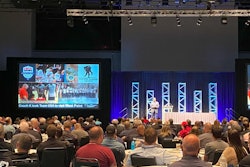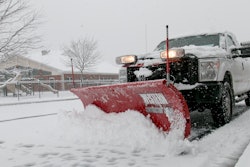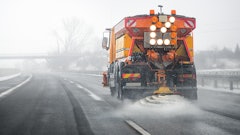
Every year, more winter maintenance contractors begin offering anti-icing and other liquid services. Between environmental concerns, client demands, increasing legislation and overall profitability, this trend will only increase in strength. If you already offer these services, then you’re a step ahead of many competitors. There are, however, ways you could be potentially doing it better. Below are six ideas to step up your anti-icing game and overcome some of the most common shortfalls we see in the industry.
1. Learn your liquids
The first step—educating yourself—is the most important. Despite the amount of industry buzz about brine, many contractors (even experienced anti-icers) still don’t fully understand what it is, beyond the basic concept of salt water. They may not know about the full spectrum of liquids, including calcium chlorides, potassium acetates, magnesium chlorides, alcohol distillates and carbohydrate-based solutions. All of these are designed for different applications, varying in cost and effective temperature ranges.
Rather than relying on one liquid, contractors should be knowledgeable of each type, considering them tools in the tool box that can be deployed as needed. When removing a bolt, a person would reach for a wrench instead of a screwdriver. Brine selection should be no different.
For example, if a contractor is going to provide anti-icing services on a shopping mall parking lot, where a winter storm is going to hit in several hours with expected temperatures ranging from 20 to 32 degrees F, then an appropriate rate of calcium chloride would be a good cost-effective solution for this scenario. If, however, the temperature will range from 0 to 15 degrees F, then the calcium chloride won’t work as well, and magnesium chloride would likely be a better choice.
A common reason why many contractors don’t use multiple types of liquids is they assume they need to purchase expensive infrastructure to make them. The best approach for most people, though, is to identify a good chemical supplier in the area to purchase liquids directly. Not only is this much easier to do, but the suppliers are also experts in the products, and they’re usually happy to share knowledge about brine.
Another reason for not considering all the available liquids is the tendency of many people to follow the status quo. It’s easy to fall into the trap of applying whatever liquid they’ve always used or applying whatever the other guys are using. Education is key to breaking these old habits and expanding into other products…and better performance.
2. Take advantage of technology
Although many contractors use basic sprayers for anti-icing, new technologies can help them make confident, informed decisions to complete the job effectively and profitably. For example, some of the industry’s latest controllers monitor real-time weather forecasts while using sensors to detect jobsite variables like temperature, humidity and surface conditions. Then, the system analyzes the combined data to recommend the appropriate liquid and application rate to best complete the job.
This technology can be taken to the next level when paired with a compatible sprayer. When the material and rate are accepted on the controller, it will automatically adjust the sprayer output according to vehicle speed to achieve the target rate precisely and consistently across the property being managed. As a result, drivers can focus on safe driving without the distraction of modifying equipment settings. And, at the end of the day, reports can be generated to show how much material was applied on each jobsite, as well as the weather conditions at the time.
Even more, some systems can calculate the optimum routes using the shortest distances between jobsites. As a result, the technology can help reduce fuel consumption, wear and tear, labor costs and other expenses.
Of course, the level of sophistication offered by the latest systems sounds intimidating to many, but great effort has been put into making these products easy to use, and, in reality, if people can use a smartphone, they can likely operate these controllers, too.
3. Dig into the data
The reporting and other data generated by technology is great, but it’s useless if a contractor doesn’t take time to analyze it and use it to make informed business decisions. Not only can this information be leveraged to make improvements in season, but it can also be used to help accurately estimate future work.
Beyond reviewing equipment data, it’s important to monitor the success of applications after they’re made. Did the material and rate used effectively manage ice, or did it not work? This is information that technology can’t provide but must still be gathered for adjusting future tactics.
It’s also important for contractors to do some of their own client research to optimize operational plans. For instance, if a manufacturing client typically has a parking lot full of cars from 6:00 in the morning until 3:00 in the afternoon, there is a lot more flexibility than a retail client with longer operating hours. The amount of traffic and probability of an incident on each site factors into decisions as well.
4. Commit to calibration
Even the most advanced equipment cannot overcome improper calibrations. In fact, many contractors perform no calibrations at all. Others may calibrate the equipment with water during the offseason when the weather is warm. This produces poor results because water has a different density than brine, and the liquids perform differently at higher temperatures than during cold weather months. The best practice is to calibrate equipment with the same materials that will be sprayed and at temperatures close to ones that will be experienced on the job.
In addition to achieving correct application rates, calibration may help contractors understand the full capabilities of their equipment. For example, if a typical application requires 10 gallons of calcium chloride per 1,000 square feet, does the sprayer even have the required output to apply the target rate in one pass? Thankfully, calibration is another area that technology can make easier. Some of today’s controls guides the user through the process, making it as simple as possible.
5. Keep an eye on input costs
For the amount of money spent on material, most contractors aren’t concerned enough with how much they’re using. On the contrary, they often feel that the more they use, the better. Unfortunately, this usually doesn’t result in better performance, just wasted material.
Because material is such a large expense, managing it wisely is key to maximizing profitability. The most successful contractors in the industry fully understand this. They know exactly how much liquid they’re putting down on each job, taking care not to over- or underapply. They’ve also gained enough education and experience in anti-icing to confidently select the appropriate liquids and rates for the conditions at hand.
6. Equip yourself appropriately
Too many contractors are ill equipped to handle their work requirements appropriately. For instance, some sprayers don’t have the output required to hit the desired application rates. As a result, the operator may compensate by driving over the property multiple times. Generally, a better approach is to invest in equipment that can handle the application rates in one pass. The increased efficiency alone can pay for the upgrade in most situations.
There are many sprayer options available on the marketplace. There are models powered by gas engines, hydraulics and electric motors. They offer various levels of sophistication, precision and cost. What matters most, of course, is return on investment.
In addition to selecting a sprayer with enough volume and output to handle the workload, a contractor should consider features that help reduce material waste. Sprayers that can apply exact rates of liquids with technology to help eliminate wasteful spraying can significantly reduce input costs to pay off the equipment investment faster.
Durability and reduced maintenance costs help achieve higher return on investment, too. Stainless steel and other corrosion-resistant components may cost more upfront, but they will also last longer. Furthermore, consider the reliability of the pumps and power systems. For instance, electric motors are simpler and lower maintenance than gas engines.
With external factors continuing to favor anti-icing and other liquid services, this trend will become much more common in the coming years. To succeed in this environment, contractors should constantly be striving to improve what they’re currently doing, so they can provide a better service and, of course, make more money.




















